Government reports suggest COVID-19 Vaccination is causing Cancer at an unprecedented rate
by
Robert Gorter, MD, PhD.
(with thanks to THE EXPOSÉ)
October 14th, 2022
Cancer begins when genetic changes interfere with the normal replication and replacement of cells in the body. Cells start to grow uncontrollably and may form a tumor. Currently, it is the No. 2 leading cause of death in the United States.
Unfortunately, it appears the disease may be on the rise thanks to the experimental Covid-19 injections. Because official U.S. Government data confirms the risk of developing cancer following Covid-19 vaccination is 1433x greater than the background risk.
The Centers for Disease Control (CDC) hosts a Vaccine Adverse Event Reporting System (VAERS) which contains historical data on adverse reactions reported against every vaccine that has been administered in the United States of America.
A quick search of the CDC VAERS database on the number of cancer cases reported as adverse reactions to the Covid-19 injections since they were first rolled out in the USA, reveals that from December 2020 up to 5th August 2022, a total of 2,579 adverse events related to cancer were made in just 1 year and 8 months.

But performing a similar search of the VAERS database on the number of cancer cases reported as adverse events to all other available vaccines between 2008 and 2020, a period of 13 years, reveals there were just 791 adverse events related to cancer.
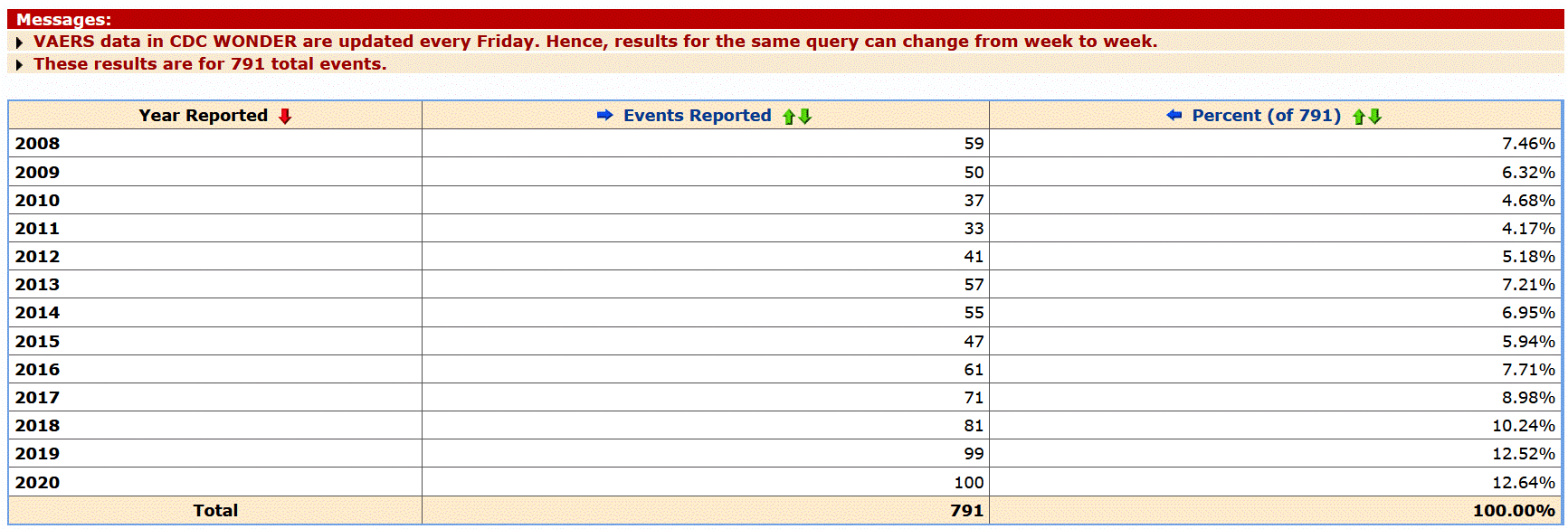
All other Vaccines
Many would simply argue without backing their claim up with any evidence, that this is just because of the volume of Covid-19 injections administered compared to all other vaccines. But unfortunately, anyone who argues this is wrong.
We can see this by looking at the number of doses administered.
The following chart shows the total number of flu vaccine doses administered in 13 full flu seasons all the way from the 2008/2009 flu season to the 2019-2020 flu season. The data has been extracted from the CDC info found here.

In all between the 08/09 flu season and the 19/20 flu season, there were a total of 1,720,400,000 (1.7204 billion) doses of the flu jab administered in the USA.
The CDC also confirms that between 2008 and 2020, a period of 13 years, there were just 64 events related to cancer reported as adverse reactions to the influenza vaccines.
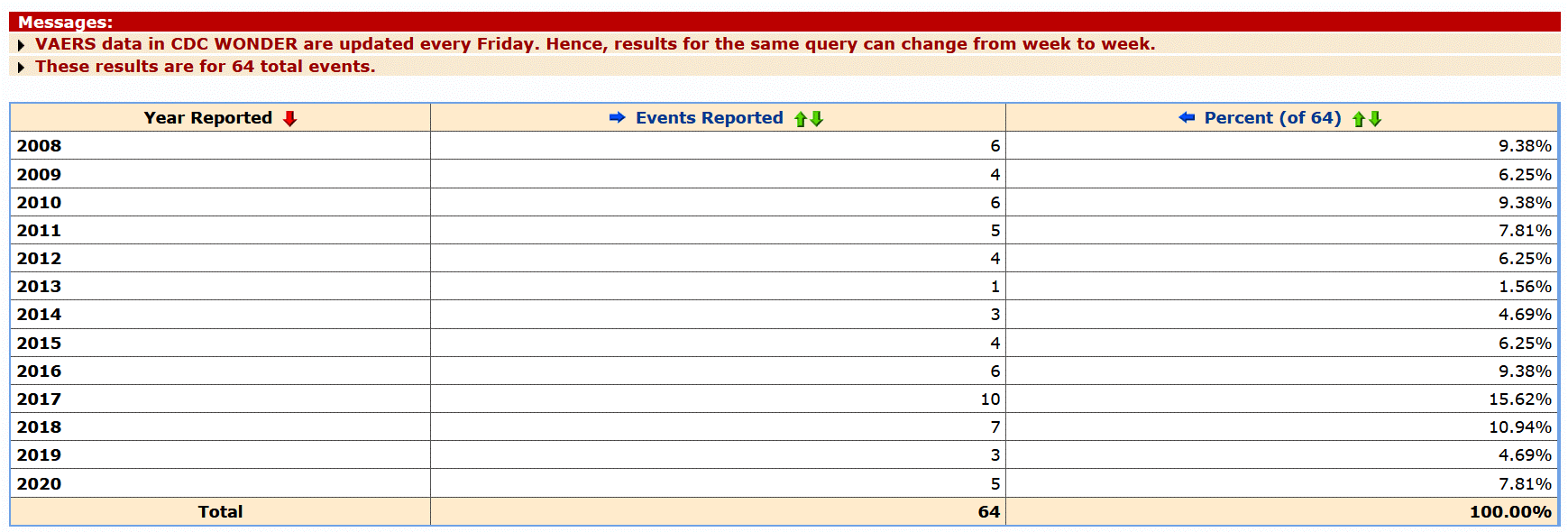
Flu Vaccines
Based on the number of adverse events related to cancer alone, we can see that there have been 40.3x as many cancer cases related to Covid-19 vaccination as there have been related to flu vaccination.
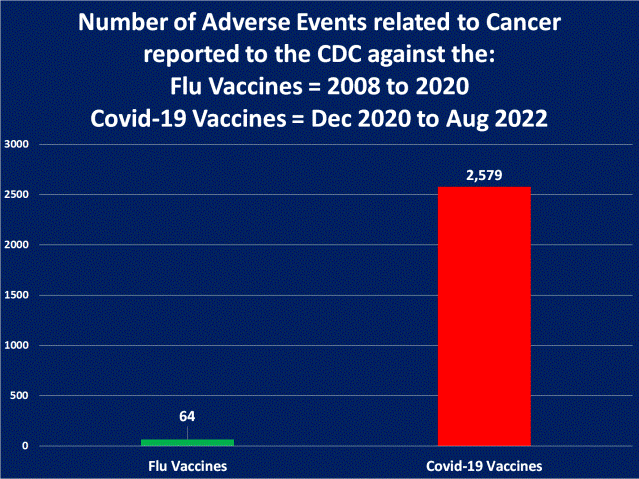
But whilst shocking, this statistic does not properly represent the severity of the situation. To do that we need to know the number of cancer cases per 100,000 doses administered.
Based on the above numbers provided by the CDC, the number of adverse events related to cancer reported per 100,000 doses of flu vaccine administered equates to just 0.0003 per 100,000 doses.
According to ‘Our World in Data’, as of 9th August 2022, 606 million doses of the Covid-19 vaccines have been administered in the USA. This means there have been actually nearly 3x as many flu vaccines administered between 2008-2020 than Covid-19 injections since the end of 2020, let alone all of the other vaccines that have been administered.
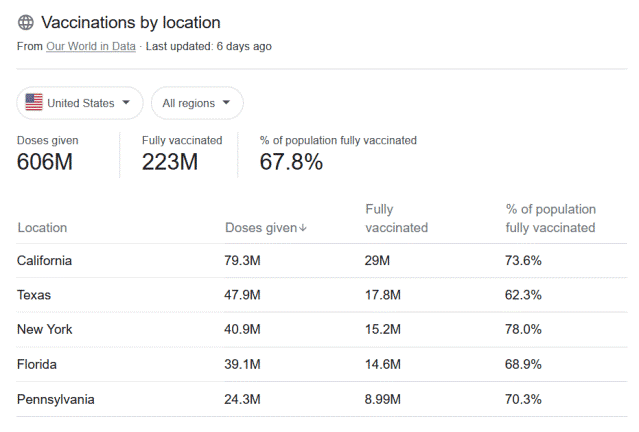
Therefore, the number of adverse events related to cancer reported per 100,000 doses of the Covid-19 vaccine administered equates to 0.43 per 100,000 doses.
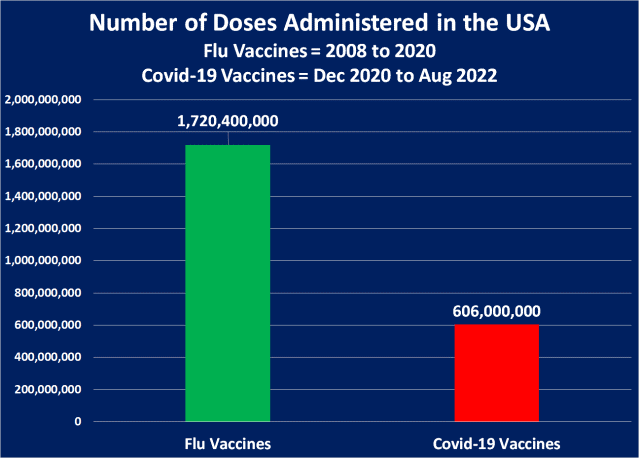
This means Covid-19 vaccination is 1433.33x / 143,233.33% more likely to cause cancer than flu vaccination. It can be argued that because the numbers are so extraordinarily low for the flu vaccine, that flu vaccination does not cause cancer. Therefore, it can be argued that the risk of developing cancer following Covid-19 vaccination is 1433x greater than the background risk.
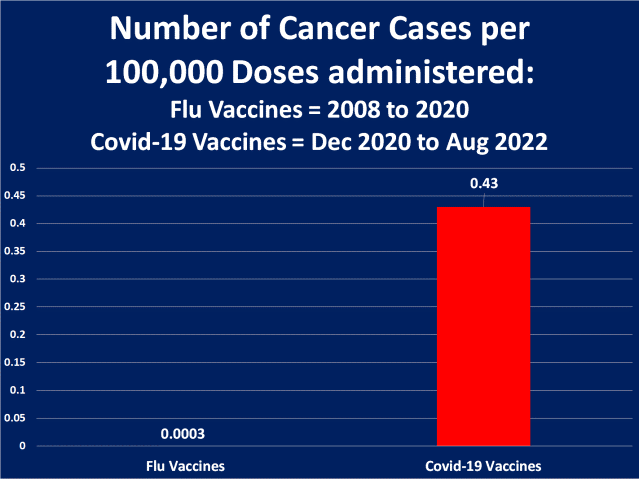
This should however not come as much of a surprise considering we already have scientific proof that the Covid-19 mRNA injections can cause cancer of the ovaries, pancreas, and breast.
The homologous recombination DNA repair pathway is one of the mechanisms that the body uses to stop your cells from turning cancerous in response to environmental stress.
And in October 2021, two revered scientists, called Jiang and Mei, had a paper published, after peer review, in MDPI, showing that the SARS-Cov-2 spike protein obliterated the DNA repair mechanism in lymphocytes.
The viral spike protein was so toxic to this pathway that it knocked 90% of it out. If the whole spike protein got into the nucleus (in the ovaries), and enough of it was produced and hung around long enough before the body was able to get rid of it all, it would cause cancer.
Fortunately, in the case of natural infection, this is unlikely to occur. But the experimental mRNA “vaccines” induce spike protein to be produced in and around the cell nucleus and this occurs for at least 60 days and almost certainly longer.
This is probably why cases of ovarian cancer are now at an all-time high. And this holds true for all forms of cancer because of the destruction of the DNA repair mechanisms in the nucleus of each cell.
Viscum album (European Mistletoe) has proven to cause a significant improvement of damaged DNA repair mechanisms in cancer patients and patients with chronic diseases alike. (see below)
Official UK data published by Public Health Scotland, which can be found here, reveal the number of women suffering from ovarian cancer from the introduction of the Covid-19 injection to the general population. Unfortunately, the known trend in 2021 was significantly higher than 2020 and the 2017-2019 average.
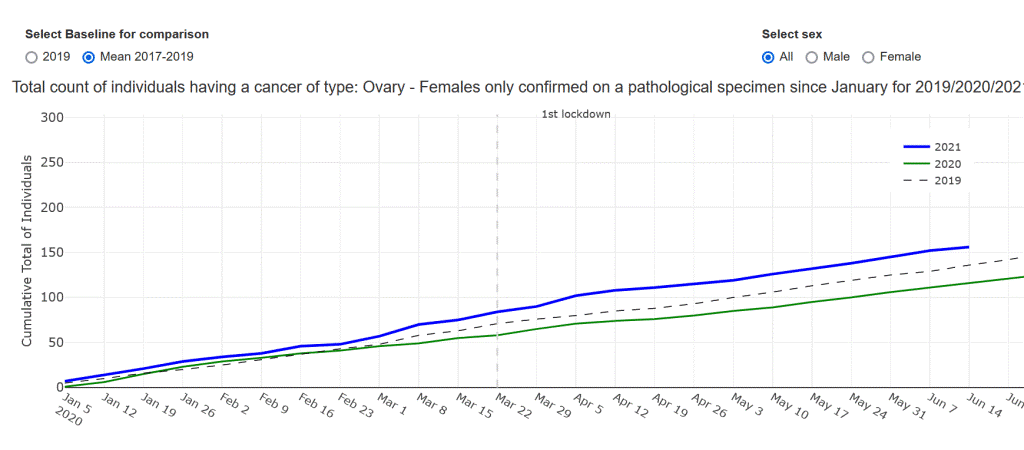
Ovarian Cancer
The above chart shows up to June 2021, but the charts found on Public Health Scotland’s dashboard now show figures all the way up to December 2021 and unfortunately reveal that the gap has widened even further with the number of women suffering from Ovarian cancer increasing significantly.

If you still wish to get a jab that doesn’t stop you from getting Covid-19, doesn’t stop you from spreading Covid-19, increases your risk of mortality significantly (see here), and increases your risk of suffering cancer by 143,233% then that’s up to you. But perhaps you can now be a little more understanding of why many others simply refuse to do so.
Dr. Gorter:
Overview of human DNA Repair Genes, their Mechanisms, and Treatment
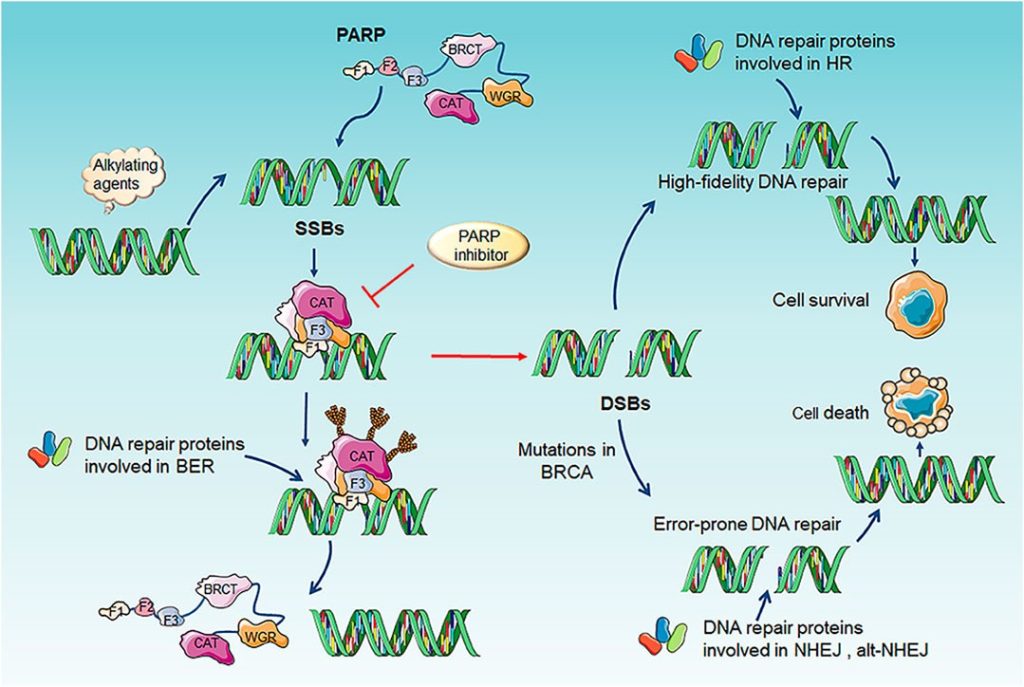
DNA Repair Mechanisms and Pathways in Cancer Therapy and Resistance
Ronen A, Glickman BW. Human DNA repair genes. Environ Mol Mutagen. 2001;37(3):241-83. DOI: 10.1002/em.1033. PMID: 11317342.
Also, when one does not smoke or drink alcohol on a daily basis and restricts glucose intake, still on average, an adult human being produces approximately 100,000 cancer cells per day. These cancer cells occur during replication (mitosis) of a cell, which must produce two identical cells but mistakes in the copying process occur by, for instance, a wrong amino acid is built in. A human cell contains 46 chromosomes; each chromosome contains tens of thousands of genes; each gene contains millions of DNA molecules. When necessary, one cell can divide into two cells within 24 hours. There, mistakes can be made in copying all DNA molecules and thus, in all genes and chromosomes. Each mistake becomes a mutation. Mutations cause an array of illnesses, including cancer. Therefore, it most essential that if a mutation by a mistake in the copying process took place, this mistake is instantly noticed and repaired.
Thus, DNA repair mechanisms are essential for the maintenance of genome integrity. Consequently, the dysregulation of repair genes can be expected to be associated with significant, detrimental health effects, which can include an increased prevalence of birth defects, an enhancement of cancer risk, and an accelerated rate of aging. Although original insights into DNA repair and the genes responsible were largely derived from studies in bacteria and yeast, well over 125 genes directly involved in DNA repair have now been identified in humans, and their cDNA sequence established. These genes function in a diverse set of pathways that involve the recognition and removal of DNA lesions, tolerance to DNA damage, and protection from errors of incorporation made during DNA replication or DNA repair. Additional genes indirectly affect DNA repair, by regulating the cell cycle, ostensibly to provide an opportunity for repair or to direct the cell to apoptosis.
For about 70 of the DNA repair genes have been identified: both the genomic DNA sequence and the cDNA sequence and chromosomal location have been elucidated. In 45 cases, single-nucleotide polymorphisms have been identified and, in some cases, genetic variants have been associated with specific disorders. With the accelerating rate of gene discovery, the number of identified DNA repair genes and sequence variants is quickly rising.
Mistletoe (Viscum album) has been shown to dramatically improve DNA repair, leading to a significant prolongation of Life Expectancy and Qualify of Life (see list of refered articles).
Mistletoe (Viscum album) in cancer therapy and in severely damaged DNA repair mechanisms directly caused by COVID-19 Injections
Patients receiving chemotherapy and/or radiation will always have significant inhibition or even destruction of their DNA repair mechanisms. Usually, chemotherapy and all forms of ionizing radiation will cause cancer by themselves. Therefore, also studies with the Viscum album document a significant improvement in life expectancy and quality of life during and after treatment with the Viscum album.
In the Gorter Model, treatment with the Viscum album is one of its cornerstones. In Europe and many other countries, Viscum album is available on prescription and often reimbursed by the national health insurance systems
Sources
Coding variants in human double-strand break DNA repair genes.
Ruttan CC, Glickman BW. Mutat Res. 2002 Nov 30;509(1-2):175-200. doi: 10.1016/s0027-5107(02)00218-x. PMID: 12427538
Human DNA repair genes, 2005.
Wood RD, Mitchell M, Lindahl T. Mutat Res. 2005 Sep 4;577(1-2):275-83. doi: 10.1016/j.mrfmmm.2005.03.007. PMID: 15922366 Review.
Human DNA repair systems: an overview.
Yu Z, Chen J, Ford BN, Brackley ME, Glickman BW. Environ Mol Mutagen. 1999;33(1):3-20. doi: 10.1002/(sici)1098-2280(1999)33:1<3::aid-em2>3.0.co;2-l. PMID: 10037319 Review.
Human cells are deficient in p53-regulated p21(waf1/cip1) expression exhibit normal nucleotide excision repair of UV-induced DNA damage.
Wani MA, Wani G, Yao J, Zhu Q, Wani AA. Carcinogenesis. 2002 Mar;23(3):403-10. doi: 10.1093/carcin/23.3.403. PMID: 11895854
The barley EST DNA Replication and Repair Database (bEST-DRRD) as a tool for the identification of the genes involved in DNA replication and repair.
Gruszka D, Marzec M, Szarejko I. BMC Plant Biol. 2012 Jun 14;12:88. doi: 10.1186/1471-2229-12-88. PMID: 22697361 Free PMC article.
Germline Mutations in DNA Repair Genes in Patients With Metastatic Castration-resistant Prostate Cancer.
Holeckova K, Baluchova K, Hives M, Musak L, Kliment J Sr, Skerenova M.
In Vivo. 2020 Jul-Aug;34(4):1773-1778. doi: 10.21873/invivo.11971. PMID: 32606146 Free PMC article.
DNA damage accumulates and responses are engaged in human ALS brain and spinal motor neurons and DNA repair is activatable in iPSC-derived motor neurons with SOD1 mutations.
Kim BW, Jeong YE, Wong M, Martin LJ. Acta Neuropathol Commun. 2020 Jan 31;8(1):7. DOI: 10.1186/s40478-019-0874-4. PMID: 32005289 Free PMC article.
Low-Level Radiofrequency Exposure Does Not Induce Changes in MSC Biology: An in vitro Study for the Prevention of NIR-Related Damage.
Alessio N, Santoro E, Squillaro T, Aprile D, Briccola M, Giubbini P, Marchesani R, Muoio MR, Lamberti M. Stem Cells Cloning. 2019 Dec 18;12:49-59. doi: 10.2147/SCCAA.S204166. eCollection 2019. PMID: 31908499 Free PMC article.
DNA Repair Gene Expression Adjusted by the PCNA Metagene Predicts Survival in Multiple Cancers.
Peterson LE, Kovyrshina T. Cancers (Basel). 2019 Apr 8;11(4):501. DOI: 10.3390/cancers11040501. PMID: 30965671 Free PMC article.
Stress and stem cells: adult Muse cells tolerate extensive genotoxic stimuli better than mesenchymal stromal cells.
Alessio N, Squillaro T, Özcan S, Di Bernardo G, Venditti M, Melone M, Peluso G, Galderisi U. Oncotarget. 2018 Apr 10;9(27):19328-19341. doi: 10.18632 / oncotarget.25039. eCollection 2018 Apr 10. PMID: 29721206 Free PMC article.
Improvement of DNA repair in lymphocytes of breast cancer patients treated with Viscum album extract (Iscador)
Kovacs E, Hajto T, Hostanska K. Improvement of DNA repair in lymphocytes of breast cancer patients treated with Viscum album extract (Iscador). Eur J Cancer. 1991;27(12):1672-6. DOI: 10.1016/0277-5379(91)90443-h. PMID: 1782081.
E Kovacs, T Hajto, K Hostanska
Articles in Regard to the Clinical Application of Viscum album
Unconventional therapies for cancer: 3. Iscador. Task Force on Alternative Therapies of the Canadian Breast Cancer Research Initiative.
Kaegi E. CMAJ. 1998 May 5;158(9):1157-9. PMID: 9597967 Free PMC article.
Use of Iscador, an extract of European mistletoe (Viscum album), in cancer treatment: prospective nonrandomized and randomized matched-pair studies nested within a cohort study.
Grossarth-Maticek R, Kiene H, Baumgartner SM, Ziegler R. Altern Ther Health Med. 2001 May-Jun;7(3):57-66, 68-72, 74-6 passim. PMID: 11347286 Clinical Trial.
The anticarcinogenic and antimetastatic activity of Iscador.
Kuttan G, Menon LG, Antony S, Kuttan R. Anticancer Drugs. 1997 Apr;8 Suppl 1:S15-6. DOI: 10.1097/00001813-199704001-00004. PMID: 9179361
Randomized and non-randomized prospective controlled cohort studies in matched-pair design for the long-term therapy of breast cancer patients with a mistletoe preparation (Iscador): a re-analysis.
Grossarth-Maticek R, Ziegler R. Eur J Med Res. 2006 Nov 30;11(11):485-95.
PMID: 17182361 Clinical Trial.
Immune modulation using mistletoe (Viscum album L.) extracts Iscador.
Büssing A. Arzneimittelforschung. 2006 Jun;56(6A):508-15. doi: 10.1055/s-0031-1296818. PMID: 16927532 Review.
Efficacy of mistletoe extract as a complement to standard treatment in advanced pancreatic cancer: study protocol for a multicentre, parallel-group, double-blind, randomized, placebo-controlled clinical trial (MISTRAL).
Wode K, Hök Nordberg J, Kienle GS, Elander NO, Bernhardson BM, Sunde B, Sharp L, Henriksson R, Fransson P. Trials. 2020 Sep 11;21(1):783. doi:10.1186 / s13063-020-04581-y. PMID: 32917288 Free PMC article.
Clinical Safety of Combined Targeted and Viscum album L. Therapy in Oncological Patients.
Chronicle A, Oei SL, Merkle A, Matthes H, Schad F. Medicines (Basel). 2018 Sep 6;5(3):100. DOI: 10.3390/medicines5030100. PMID: 30200590 Free PMC article.
Evaluation of Preclinical Assays to Investigate an Anthroposophic Pharmaceutical Process Applied to Mistletoe (Viscum album L.) Extracts.
Baumgartner S, Flückiger H, Kunz M, Scherr C, Urech K. Evid Based Complement Alternat Med. 2014;2014:620974. doi: 10.1155/2014/620974. Epub 2014 May 4. PMID: 24876872 Free PMC article.
Oncopharmacological Perspectives of a Plant Lectin (Viscum album Agglutinin-I): Overview of Recent Results from in vitro Experiments and in vivo Animal Models, and Their Possible Relevance for Clinical Applications.
Hajtó T, Hostanska K, Berki T, Pálinkás L, Boldizsár F, Németh P. Evid Based Complement Alternat Med. 2005 Mar;2(1):59-67. DOI: 10.1093/exam/neh058. Epub 2005 Jan 28. PMID: 15841279 Free PMC article.
Unconventional therapies for cancer: 3. Iscador. Task Force on Alternative Therapies of the Canadian Breast Cancer Research Initiative.
Kaegi E. CMAJ. 1998 May 5;158(9):1157-9. PMID: 9597967 Free PMC article.